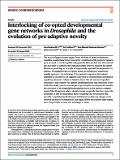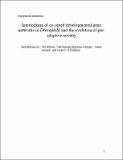Por favor, use este identificador para citar o enlazar a este item:
http://hdl.handle.net/10261/338492COMPARTIR / EXPORTAR:
 SHARE SHARE
 CORE
BASE CORE
BASE
|
|
| Visualizar otros formatos: MARC | Dublin Core | RDF | ORE | MODS | METS | DIDL | DATACITE | |

| Campo DC | Valor | Lengua/Idioma |
|---|---|---|
| dc.contributor.author | Molina-Gil, Sara | es_ES |
| dc.contributor.author | Sotillos, Sol | es_ES |
| dc.contributor.author | Espinosa-Vázquez, José Manuel | es_ES |
| dc.contributor.author | Almudi, Isabel | es_ES |
| dc.contributor.author | Castelli-Gair Hombría, James | es_ES |
| dc.date.accessioned | 2023-11-07T11:17:07Z | - |
| dc.date.available | 2023-11-07T11:17:07Z | - |
| dc.date.issued | 2023-09-15 | - |
| dc.identifier.citation | Nature Communications 14: 5730 (2023) | es_ES |
| dc.identifier.uri | http://hdl.handle.net/10261/338492 | - |
| dc.description | 13 Páginas.-- 7 Figuras | es_ES |
| dc.description.abstract | The re-use of genes in new organs forms the base of many evolutionary novelties. A well-characterised case is the recruitment of the posterior spiracle gene network to the Drosophila male genitalia. Here we find that this network has also been co-opted to the testis mesoderm where is required for sperm liberation, providing an example of sequentially repeated developmental co-options. Associated to this co-option event, an evolutionary expression novelty appeared, the activation of the posterior segment determinant Engrailed to the anterior A8 segment controlled by common testis and spiracle regulatory elements. Enhancer deletion shows that A8 anterior Engrailed activation is not required for spiracle development but only necessary in the testis. Our study presents an example of pre-adaptive developmental novelty: the activation of the Engrailed transcription factor in the anterior compartment of the A8 segment where, despite having no specific function, opens the possibility of this developmental factor acquiring one. We propose that recently co-opted networks become interlocked, so that any change to the network because of its function in one organ, will be mirrored by other organs even if it provides no selective advantage to them. | es_ES |
| dc.description.sponsorship | We thank Dr. Steve Brown and Dr. Maria Luisa Rivas for helping with the isolation of the upd0.43 cis-regulatory element, Dr. Fernando Casares and his laboratory members for help with Episyrphus cultures and Dr. Judith Kassis for stocks. This work was supported by Ministerio de Ciencia e Innovación grants BFU2016-76528 and PID2019-104656GB-I00 co-funded by the European Regional Development Fund (FEDER) to J.C.-G.H. and by the Spanish Ministry of Science and Innovation (PID2020-116041GB-I00) and Leonardo Grants for Researchers and Cultural Creators 2021 from BBVA Foundation (IN[21]_CMA_BIO_0056) to I. A. The CABD is supported by a María de Maeztu Unit excellence grant CEX-2020-001088-M. | es_ES |
| dc.language.iso | eng | es_ES |
| dc.publisher | Springer Nature | es_ES |
| dc.relation | info:eu-repo/grantAgreement/AEI/Plan Estatal de Investigación Científica y Técnica y de Innovación 2017-2020/PID2019-104656GB-I00/ES/DESARROLLO, REGULACION GENICA Y EVOLUCION DE LAS ESTRUCTURAS CEFALICAS DE DROSOPHILA/ | es_ES |
| dc.relation | info:eu-repo/grantAgreement/AEI/Plan Estatal de Investigación Científica y Técnica y de Innovación 2017-2020/PID2020-116041GB-I00/ES/LOS NUEVOS OJOS DE LAS EFIMERAS COMO MODELO PARA ENTENDER EL ORIGEN, FUNCION Y EL POTENCIAL ADAPTATIVO DE LAS NOVEDADES MORFOLOGICAS/ | es_ES |
| dc.relation.ispartof | Nature communications | es_ES |
| dc.relation.isversionof | Publisher's version | es_ES |
| dc.rights | openAccess | es_ES |
| dc.title | Interlocking of co-opted developmental gene networks in Drosophila and the evolution of pre-adaptive novelty | es_ES |
| dc.type | artículo | es_ES |
| dc.identifier.doi | 10.1038/s41467-023-41414-3 | - |
| dc.description.peerreviewed | Peer reviewed | es_ES |
| dc.relation.publisherversion | https://doi.org/10.1038/s41467-023-41414-3 | es_ES |
| dc.rights.license | https://creativecommons.org/licenses/by/4.0/ | es_ES |
| dc.contributor.funder | Ministerio de Ciencia e Innovación (España) | es_ES |
| dc.contributor.funder | European Commission | es_ES |
| dc.contributor.funder | Fundación BBVA | es_ES |
| dc.relation.csic | Sí | es_ES |
| oprm.item.hasRevision | no ko 0 false | * |
| dc.identifier.funder | http://dx.doi.org/10.13039/501100000780 | es_ES |
| dc.identifier.funder | http://dx.doi.org/10.13039/501100004837 | es_ES |
| dc.identifier.funder | http://dx.doi.org/10.13039/100007406 | es_ES |
| dc.identifier.pmid | 37714829 | - |
| dc.identifier.scopus | 2-s2.0-85171375096 | - |
| dc.identifier.url | https://api.elsevier.com/content/abstract/scopus_id/85171375096 | - |
| dc.type.coar | http://purl.org/coar/resource_type/c_6501 | es_ES |
| item.grantfulltext | open | - |
| item.openairetype | artículo | - |
| item.cerifentitytype | Publications | - |
| item.languageiso639-1 | en | - |
| item.fulltext | With Fulltext | - |
| item.openairecristype | http://purl.org/coar/resource_type/c_18cf | - |
| Aparece en las colecciones: | (IG) Artículos | |
Ficheros en este ítem:
| Fichero | Descripción | Tamaño | Formato | |
|---|---|---|---|---|
| NatureComm_2023_V14_5730.pdf | Artículo principal | 7,53 MB | Adobe PDF |  Visualizar/Abrir |
| NatureComm_2023_V14_5730_MatSuppl.pdf | Material suplementario | 2,52 MB | Adobe PDF |  Visualizar/Abrir |
| NatureComm_2023_V14_5730_MatSuppl2.xlsx | Material suplementario | 11,81 kB | Microsoft Excel XML | Visualizar/Abrir |
CORE Recommender
Page view(s)
21
checked on 13-may-2024
Download(s)
24
checked on 13-may-2024
Google ScholarTM
Check
Altmetric
Altmetric
Este item está licenciado bajo una Licencia Creative Commons

